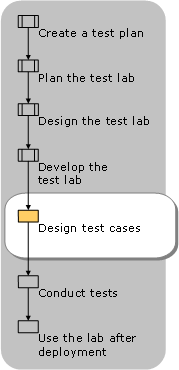A test case is a detailed procedure that fully tests a feature or an aspect of a feature. Whereas the test plan describes what to test, a test case describes how to perform a particular test. You need to develop a test case for each test listed in the test plan. Figure 2.10 illustrates the point at which test case design occurs in the lab development and testing process.....
A test case is a detailed procedure that fully tests a feature or an aspect of a feature. Whereas the test plan describes what to test, a test case describes how to perform a particular test. You need to develop a test case for each test listed in the test plan. Figure 2.10 illustrates the point at which test case design occurs in the lab development and testing process.

A test case includes:
- The purpose of the test.
- Special hardware requirements, such as a modem.
- Special software requirements, such as a tool.
- Specific setup or configuration requirements.
- A description of how to perform the test.
- The expected results or success criteria for the test.
Test cases should be written by a team member who understands the function or technology being tested, and each test case should be submitted for peer review.
Organizations take a variety of approaches to documenting test cases; these range from developing detailed, recipe-like steps to writing general descriptions. In detailed test cases, the steps describe exactly how to perform the test. In descriptive test cases, the tester decides at the time of the test how to perform the test and what data to use.
Most organizations prefer detailed test cases because determining pass or fail criteria is usually easier with this type of case. In addition, detailed test cases are reproducible and are easier to automate than descriptive test cases. This is particularly important if you plan to compare the results of tests over time, such as when you are optimizing configurations. Detailed test cases are more time-consuming to develop and maintain. On the other hand, test cases that are open to interpretation are not repeatable and can require debugging, consuming time that would be better spent on testing.
Test Case Design
Test Case ID:
It is unique number given to test case in order to be identified.
Test description:
The description if test case you are going to test.
Revision history:
Each test case has to have its revision history in order to know when and by whom it is created or modified.
Function to be tested:
The name of function to be tested.
Environment:
It tells in which environment you are testing.
Test Setup:
Anything you need to set up outside of your application for example printers, network and so on.
Test Execution:
It is detailed description of every step of execution.
Expected Results:
The description of what you expect the function to do.
Actual Results:
pass / failed
If pass - What actually happen when you run the test.
If failed - put in description of what you've observed.





 本文详细介绍了测试用例的设计过程及组成要素,包括测试目的、特殊软硬件需求、配置要求等,并探讨了不同类型的测试用例及其优缺点。
本文详细介绍了测试用例的设计过程及组成要素,包括测试目的、特殊软硬件需求、配置要求等,并探讨了不同类型的测试用例及其优缺点。
















 2703
2703

 被折叠的 条评论
为什么被折叠?
被折叠的 条评论
为什么被折叠?








